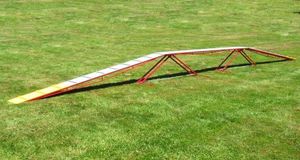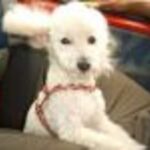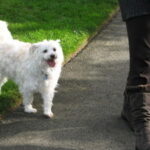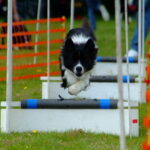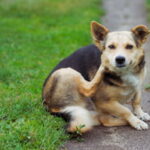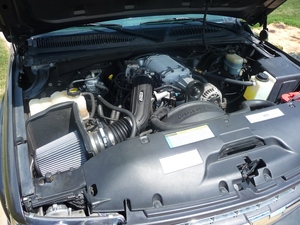In agility, there are several unique obstacles in which a dog must negotiate. Each of these obstacles are different in the way the must be performed. If you are new to agility, the variety of obstacles may be confusing for you. The following is a guide to every agility obstacle in AKC.
Contacts
A-Frame
The A-Frame is the tallest of all of the obstacles, as it stands 5’8 at the apex. It is called the A-Frame because it consists of two slanted, wooden boards that meet and form the shape of an “A.” It comes in many different colors, but it is most often seen in blue and yellow. While most of the frame is painted blue, there are several inches of yellow painted on the bottom sides of it. This yellow area is known as the “contact zone.” In AKC competition, your dog must hit at least one paw in the yellow on the down side of the A-Frame, but the up side isn’t judged. You will most likely have to train for a touch somewhere in the contact zone, but some dogs have the natural stride to do a running A-Frame.
Dogwalk
The dogwalk is very similar in design to a catwalk. The name was just switched around so it would fit agility competitions for dogs. There are three parts: the up plank, the longer straight plank, and the down plank. The straight board is connected to the other planks. It is also most often seen as blue and yellow, and it also has contact zones. It is slightly narrower than the A-Frame, so the dog must have good balance to stay on it. Your dog must hit both contact zones, however, unlike the A-Frame, where your dog only has to touch the down side’s contact zone. Again, you will most likely have to train for some kind of touch in the contact zone for accuracy.
Teeter
The most difficult contact obstacle for most dogs is the teeter. It takes a while to train properly, and many dogs dislike the dropping motion. They especially hate when the teeter slams onto the ground. There are also yellow contact zones, and both areas must be touched by at least one of the dog’s paws. Oftentimes, a dog tiptoes up to the drop point and waits for the teeter to fall. This takes very long, and many dogs lose patience and jump off before the teeter touches the ground. To complete the required teeter performance, dogs must hit the yellow and stay on the teeter until it makes contact with the ground.
Jumps
Single Jump
The easiest and simplest of all the jumps is the single jump. The altitude of the bars depends on your dog’s measured height. All your dog must do it complete the jump without knocking the bar down.
Double Jump
The double jump is slightly more difficult than the single jump. The width is greater, but the height remains the same. To complete this jump, your dog must jump longer to get across, as well as high even to span the height. No bars may be knocked down, either.
Triple Jump
The triple jump is more complex than the single and double jumps. The first bar is the lowest height, the second is slightly higher, and the third bar is your dog’s required jump height. Your dog must clear the span of the entire jump without knocking any bars to complete is successfully.
Broad Jump
The broad jump is the shortest and longest of all the jumps. The dog must jump flat and stretch to get across the short boards. Several dogs walk across the boards when they are first learning how to jump this obstacle, so you must encourage your dog to jump. Your dog may not jump across it diagonally, but straight and in between the four posts that are set as guidelines for jumping direction.
Panel Jump
The panel is unlike any of the other jumps. The dog sees a solid obstacle, and they must jump blindly, since they can’t see the footing on the other side. Again, the height of the panel jump depends on your dog’s measured height.
Tunnels
Regular Tunnel
The regular tunnel is exactly what it seems: a plain tunnel. The length usually between ten to twenty feet and the colors always vary. All your dog must do is find the correct entrance and run through it. Most dogs love zipping through these obstacles, so you shouldn’t have any trouble.
Chute
This tunnel consists of a short barrel with a flat fabric chute attached. The dog must run through the barrel and pick up enough speed to get through the chute without getting tangled. Many dogs are fearful for the chute part at first, but showing them the exit gives them confidence to eventually make it through alone. Any dog can do the chute, and most dogs come to love it with enough training.
Misc. Obstacles
Tire
This obstacle is very simple for dogs to learn. All the dogs have to dog is get their bodies through the middle of the tire. The height of the tire depends on the dog’s measured jump height. As long as your dog gets through the tire and doesn’t go under it, he has successfully completed the obstacle.
Pause Table
The pause table is the only obstacle in AKC agility in which your dog is required to stop. For five full seconds, the dog must wait in a sit or a down position. The judge decides on the dog’s position on the table before you begin walking the course. It’s always best to teach your dog that the table is a wonderful place to be, and he will be happy to get on and into position in competition.
Weave Poles
The weave poles are one of the most difficult obstacles in agility. Depending on the level that your dog is competing at, there will be six to twelve poles. Your dog must enter with the first poles to his left, and he must weave continuously through the poles until he reaches the end of the set. Some people train their dog to bounce in and out of the poles, others teach their dogs to weave through the poles. Whatever method you choose, it’s always best to try what would work for your dog.
Agility is a great sport for any dog owner. Even if you’re just doing agility for fun, it’s still good to know what the obstacles are. If you choose to compete, then knowing the obstacles is all the more important to you and your dog.
